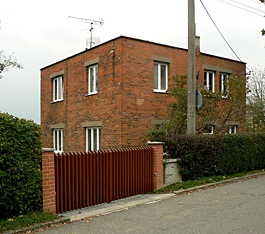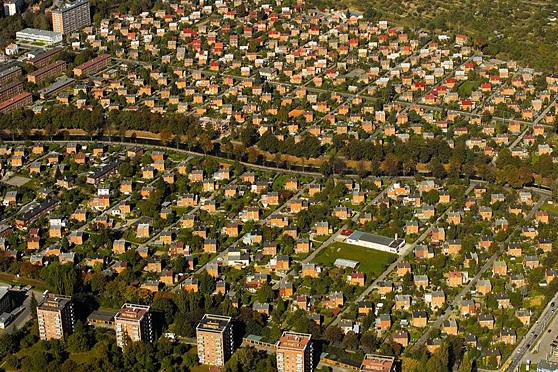
Baťa houses have a charm even after 90 years since their construction.
 |
The houses with gardens and typical brick façades were home to workers employed in Baťa factories. Baťa wanted his employees not to exhaust themselves commuting to work, so he ensured they had accommodation as close to the factory as possible. In the Zlín districts of Letná, Podvesná, Zálešná, Nad Ovčírnou, Lazy, and Díly, over two thousand buildings gradually arose, which still give Zlín its characteristic appearance today. The first houses had mansard roofs, while the later ones had flat roofs.
"There were several levels of housing here. Dormitories for single men, boarding houses for young people and students, and family housing. The highest standard here was single-family homes. However, construction began with quarter-houses, where four families lived. The most widespread type was then half-houses, where two families lived. Each had an entrance from their side and each had their own garden," Ressová explained.
According to her, the houses meet the standards of modern housing after renovations. "They have a lot of remaining lifespan, but the structures are generally quite healthy, the wood still functions, and the bricks are still load-bearing. The biggest problem is not with the statics, but with the thermal insulation of the houses, which does not meet today's requirements. It is necessary to replace all internal installations, reconstruct the bathroom and kitchen, and insulate the house and roof," the architect described the necessary adjustments of the aging buildings.
According to her, it is best if the owner respects the originality of their house. "The best clients are those who like the houses as they are and do not demand, for example, plastic windows. They find that living in the Baťa development has its charm. Inside, it is possible to come up with many interesting solutions that suit the investor. Even though it is based on modesty, it is still a nice living space with a garden within walking distance to the center," Ressová believes.
Basic reconstruction of period buildings costs about 300,000 crowns, but depending on the client's requirements, costs can rise to as much as two million. "That is if a person wants everything newly insulated, with changed installations and heating," added the architect.
In previous years, two Baťa houses collapsed during renovations. Last November, a building fell in Letná, and in July 2008, part of a house in Podvesná collapsed. However, according to Ressová, if basic static requirements are followed, the risk is not present. "I saw one of the houses about two days before it collapsed, and I was amazed at how someone could do something like that. It was a great negligence on the part of the investor and the construction company," she concluded.
 |
The English translation is powered by AI tool. Switch to Czech to view the original text source.
0 comments
add comment










